Asbestos tile, a once popular choice for flooring in homes and commercial buildings, has seen its reputation tarnished due to the health risks associated with its inhalation. However, many buildings still have these tiles, leaving property owners wondering about safe methods for their upkeep. One common question that arises is: “Can you paint over asbestos tile?” In this article, we will delve into this question, providing you with a comprehensive understanding of the possibilities and safety considerations when dealing with asbestos tiles.
What Paint Can I Use On Asbestos Tiles?
When choosing a paint for asbestos tiles, it’s crucial to opt for a product that adheres well to the tile’s surface without causing any damage.
These paints can effectively create a seal over the tile, assisting in encapsulating the asbestos fibers and reducing the potential risk of their release. Before applying the paint, it is crucial to ensure that the surface is thoroughly clean and devoid of any dust or debris. Always remember, the process of painting should be handled with care to avoid disturbing the asbestos fibers. Before embarking on any renovation work that involves materials containing asbestos, it is highly recommended to seek guidance from a qualified professional.How to Paint Asbestos Tiles
Here’s how to safely paint over asbestos tiles:
- Preparation: Start by cleaning the area and removing dust or debris from the tile surface. Ensure the area is dry before painting.
- Safety Measures: To avoid direct contact with asbestos, wear protective clothing like a mask and gloves. Avoid sanding or scraping the tiles as it can release dangerous asbestos fibers into the air.
- Primer Application: Using a paint roller, apply a layer of primer to the tiles. This will enhance the adherence of the paint to the surface, resulting in a better overall finish. Ensure that the primer is given ample time to completely dry before moving forward.
- Painting: After allowing the primer to fully dry, apply a coat of epoxy or latex paint onto the tiles. Apply the paint evenly, taking care not to apply too much pressure which could potentially damage the tiles.
- Drying: Ensure sufficient drying time between each coat for optimal results. This can vary from a few hours to overnight, depending on the paint manufacturer’s instructions.
- Sealing: After the final coat of paint has fully dried, apply a sealant to further encapsulate the asbestos fibers. This enhances security, preventing potential asbestos fiber release. [1]
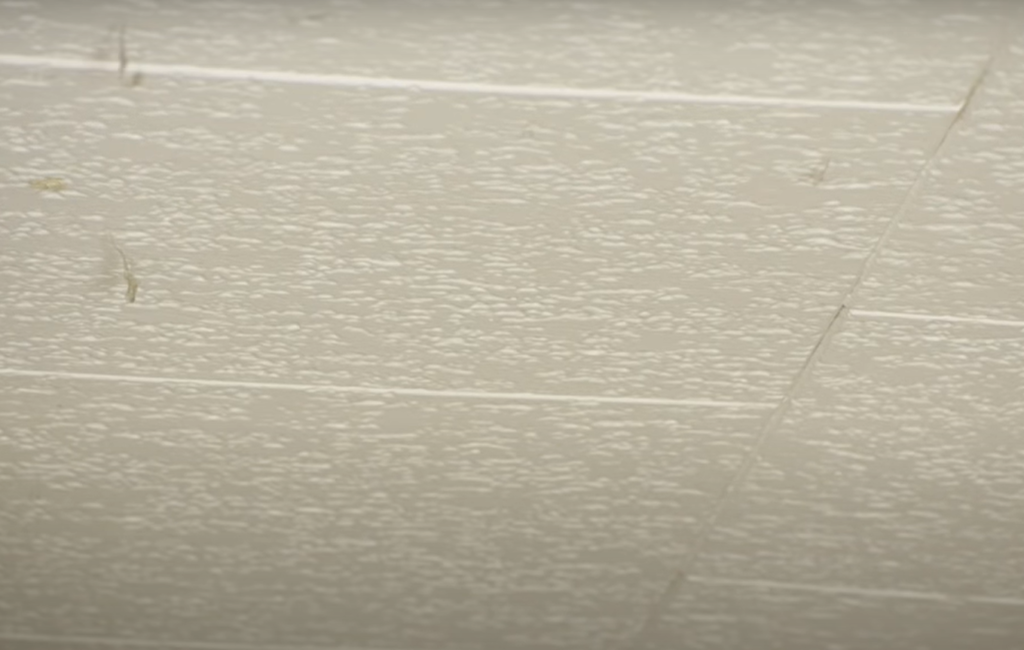
Remember, while this process can be done DIY, it’s often recommended to consult with or hire a professional when dealing with asbestos, to ensure all safety precautions are met.
Painting the Floor
When painting a floor with asbestos tiles, it’s vital to follow the same steps as above with some extra precautions. Start by thoroughly cleaning the floor with a mild detergent, rinsing it well, and letting it dry completely. Apply a layer of primer using a paint roller, ensuring even coverage, and let it dry as recommended by the manufacturer.
After the primer is dry, apply the first coat of epoxy or latex paint. Use a roller for the main area and a brush for the corners and edges. Apply paint evenly to avoid tile lifting or cracking. Let the first coat dry fully before applying a second coat, if needed.
After achieving desired coverage and allowing the paint to fully dry, apply a sealant. This adds an extra layer of protection and gives the floor a polished look. It’s crucial to let the sealant dry fully before walking on the floor or placing any furniture.
Remember, any activity that might disturb asbestos tiles, such as scrubbing vigorously or moving furniture, can release hazardous fibers into the air. Therefore, it’s often safer and more efficient to hire professionals to perform these tasks. If you decide to do it yourself, be sure to follow all safety precautions meticulously.
Is Asbestos Tile Under Carpet Safe?
Whether asbestos tile under a carpet is safe or not largely depends on the condition of the tiles and how they are handled. Asbestos-based materials pose minimal risk unless the asbestos fibers become airborne and are inhaled. If the tiles are in good condition and undisturbed under a carpet, they typically do not pose a risk. While installing or removing carpet, there is a chance that the tiles may become disturbed, resulting in the release of asbestos fibers.

It is crucial to be aware that any damage to the tiles can potentially lead to exposure to asbestos, posing significant health risks.
They can conduct a thorough assessment and guide you on the best and safest course of action.Remember, asbestos should always be handled with caution. Even though it can be safe under certain conditions, the risks associated with its disturbance should never be overlooked. [2]
How to Safely Remove Asbestos Tiles
Removing asbestos tiles requires utmost caution and adherence to safety measures to prevent the release of dangerous asbestos fibers. In many cases, it’s recommended to hire professionals to carry out this job. However, if you choose to undertake this task yourself, follow these steps:
- To ensure safety, begin by clearing the space of all furniture and effectively sealing it with plastic sheets. This precautionary measure will prevent the dispersion of asbestos fibers to other areas of the building.
- Always wear personal protective equipment: respirator (with a HEPA filter), disposable coveralls, rubber gloves, and boots. Ensure that your entire body is covered to protect against asbestos exposure.
- Wet the tiles with water mixed with a small amount of detergent. This prevents the asbestos fibers from becoming airborne, ensuring their containment.
- Carefully lift the tiles using a wide putty knife or other similar tool. Try to keep the tiles whole to minimize the release of asbestos fibers.
- Place the removed tiles in specially marked asbestos waste bags. These bags must be sealed and disposed of properly according to your local laws and regulations.
- Once all tiles are removed, the area should be thoroughly cleaned using a HEPA vacuum.
- After the removal and cleaning, it’s advisable to have the area inspected by a qualified professional to ensure all asbestos has been properly removed.
The Equipment for Safe Asbestos Flooring Removal
When dealing with asbestos tiles removal, it’s crucial to have the right equipment to ensure safety. Here is a list of essential gear:
- Personal Protective Equipment (PPE)
- Sealable Asbestos Waste Bags
- Putty Knife or Floor Scraper
- HEPA Vacuum
- Plastic Sheets
- Spray Bottle with Water and Detergent [3]
When Should I Remove Asbestos Tiles?
The decision to remove asbestos tiles should not be taken lightly, as it carries risks. In general, if the tiles are in good condition and are not being disturbed, leaving them in place is often the safest option. However, removal may be necessary under specific circumstances. These include if the tiles are deteriorating, or if renovation or remodeling work would disturb them. Likewise, if you intend to sell your property, prospective buyers might prioritize the removal of asbestos.
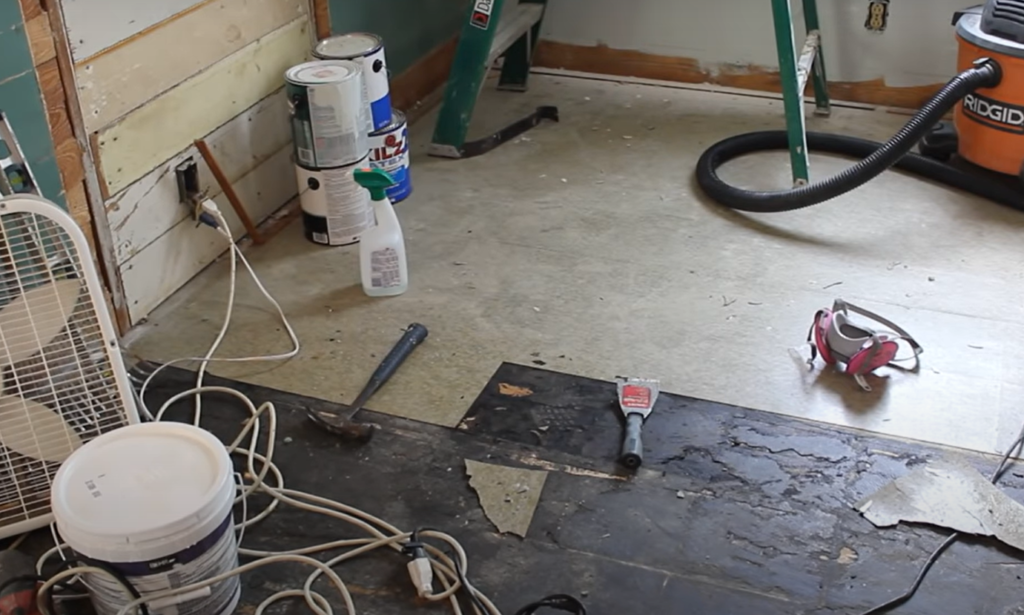
It is crucial to consult an asbestos abatement professional to properly assess the situation and determine the best course of action. They can help identify risk factors, guide safe removal practices, or suggest encapsulation techniques that seal the tiles in place without disturbing the asbestos. Remember, safety is paramount when dealing with asbestos, so always seek professional advice.
How to Seal Asbestos Tiles
Sealing, or encapsulating, asbestos tiles is a safer and less expensive alternative to removal. This process involves covering the tiles with a protective barrier to prevent the release of asbestos fibers. Here’s how to safely encapsulate asbestos tiles:
- Preparation
- Choosing the Right Product
- Applying the Sealant
- Drying Time
- Additional Flooring [4]
FAQ
Can you cover asbestos tile?
Yes, you can cover asbestos tile as long as it is in good condition and not releasing asbestos fibers. This is often considered a safer and more cost-effective alternative to removal. You can cover asbestos tile by encapsulating it with a special sealant, and then installing new flooring on top. This could be carpet, vinyl, hardwood, or new tiles. This method works by creating a barrier between the asbestos tiles and the room, preventing the release of harmful asbestos fibers.
Is it safe to paint asbestos ceiling tiles?
Yes, painting asbestos ceiling tiles is generally considered safe as long as the asbestos is not disturbed during the process.
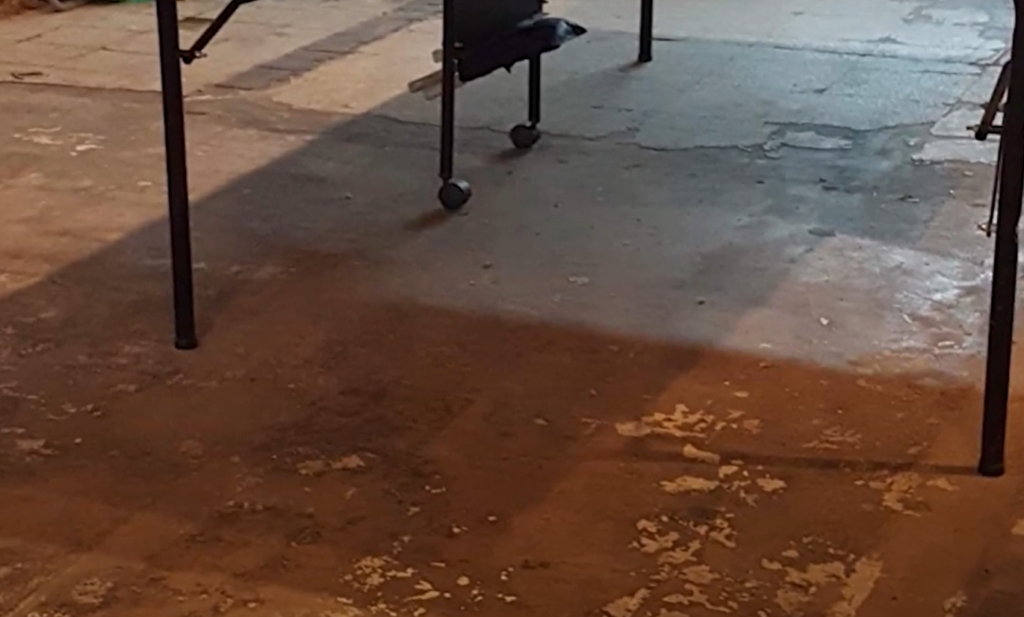
This can serve as a form of encapsulation, trapping potential asbestos fibers within the paint and preventing them from becoming airborne. However, it’s crucial to use the right type of paint and to apply it with care to avoid damaging the tiles. Never sand, drill, or scrape asbestos tiles, as these actions can release harmful asbestos fibers into the air.
Can you seal old asbestos floor tiles?
Yes, old asbestos floor tiles can be sealed, a process known as encapsulation. This involves applying a sealant product specifically designed to lock in the asbestos fibers and prevent them from becoming airborne. The sealant can be either a paint-like form that provides a protective coating or a built-up adhesive form that fills small cracks and divots. The process should be done with care to avoid damaging the tiles, which might release harmful asbestos fibers. If the tiles show signs of damage or deterioration, it is always advisable to consult with a professional. Proper encapsulation can prolong the life of the tiles and is often a more cost-effective alternative to removal.
What is the best paint for asbestos tiles?
The best paint for asbestos tiles is a product specifically designed for asbestos encapsulation, which can safely seal the asbestos fibers. These sealants come in two forms: a paint-like form that creates a thin, protective coating, or a built-up adhesive form that can fill small cracks and divots. One such product is Fiberlock ABC Asbestos Binding Compound, a high solids asbestos encapsulant/sealant, designed to encapsulate the asbestos fibers, thus preventing them from becoming airborne. The choice of product may depend on the condition of the tiles, with the adhesive from being more suitable for tiles with minor damage.
Can I paint over asbestos?
Yes, it is possible to paint over asbestos as a method of encapsulating the material and preventing the release of harmful fibers into the air. It’s a relatively cost-effective and less disruptive solution than removing the tiles completely. However, it is critical to use the right kind of paint designed for asbestos encapsulation and to avoid disturbing the asbestos during the painting process. Sanding, drilling, or scraping the tiles can release asbestos fibers and should be avoided. Also, the asbestos material and paint should be in good condition and it should be applied by a professional, or under professional guidance.
Are asbestos floor tiles toxic?
Yes, asbestos floor tiles can potentially be toxic if the asbestos fibers within the tiles become airborne. Asbestos is a naturally occurring mineral that was once widely used due to its heat resistance, strength, and insulating properties.
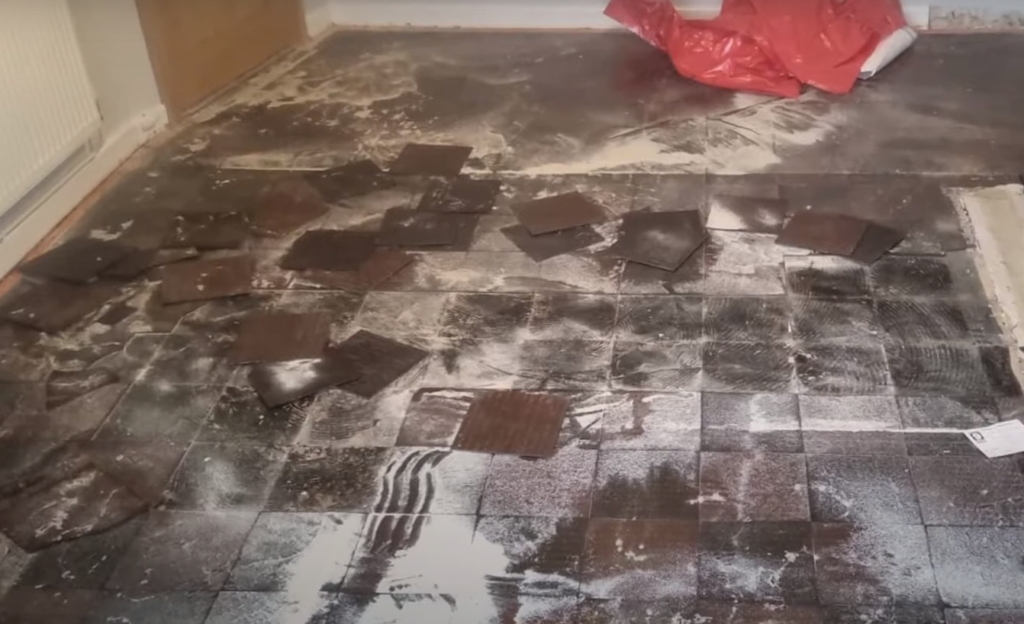
However, when disturbed, asbestos can release tiny fibers, which if inhaled, can cause health issues such as lung disease and cancer. It’s important to note that asbestos floor tiles that are in good condition and undisturbed are not likely to release these fibers and are generally considered safe. Disturbing the tiles through actions such as breaking, drilling, or scraping can release the harmful asbestos fibers into the air.
How can you tell if floor tiles are asbestos?
Identifying asbestos floor tiles can be challenging due to the lack of distinctive marks or labels, but there are some general indicators. Asbestos was widely used in floor tiles during the 20th century, particularly between the 1920s and 1980s. If your house was built or renovated during this period, the tiles could contain asbestos.
The tiles may have a shiny, marbled, or speckled appearance and are often found in earth tones. Remember, these are only indications; the only definitive way to know if your tiles contain asbestos is through professional testing.How can you tell if a floor is asbestos?
Determining if a floor contains asbestos can be quite tricky, as there are no obvious signs visible to the untrained eye. It’s important to note that asbestos was often used in the manufacturing of vinyl tiles and sheet flooring from the 1920s to the 1980s, so floors installed during these years might contain asbestos. Frequently, asbestos-containing floor tiles were produced in three sizes: 9″x9″, 12″x12″, and 18″x18″. The tiles are typically thicker than most modern vinyl tiles and may have a white, brown, or gold color on the bottom side. However, these are only general indicators and not definitive proof. The only sure way to determine if a floor contains asbestos is by having a sample of the material tested by a certified asbestos professional or laboratory.
Is asbestos ceiling cancerous?
Yes, asbestos ceilings can potentially pose a health risk, including the development of cancer, if they are degraded or disturbed in such a way that the asbestos fibers become airborne. Inhaling these tiny fibers can lead to serious health conditions such as asbestosis, lung cancer, and mesothelioma, which is a rare and aggressive form of cancer that primarily affects the lining of the lungs and the abdominal cavity. It is important to note that asbestos ceilings in good condition and left undisturbed are generally not a direct hazard.
Can you spray paint over the asbestos ceiling?
Yes, you can spray paint over an asbestos ceiling as a method of encapsulation, which can prevent the release of harmful asbestos fibers into the air. Using a spray application minimizes the physical contact with the asbestos material and reduces the risk of disturbing it. However, it’s crucial to use a specific type of paint known as an asbestos encapsulant. This type of paint is designed to bind the asbestos fibers together and prevent them from becoming airborne. As with any asbestos-related work, if you choose to spray paint over the asbestos ceiling, it should be done by a professional or under professional guidance to ensure safety.
Useful Video: How to Paint And Seal Asbestos Mastic With PerfectPaint
Conclusion
While dealing with asbestos materials, including floor tiles and ceilings, it’s crucial to prioritize safety. These materials can potentially be harmful, leading to serious health conditions when disturbed. Therefore, it’s advisable to avoid any DIY activities that may release asbestos fibers into the air. As for painting over asbestos tiles or ceilings, it can be done as a form of encapsulation using specific asbestos encapsulant paint. This should be applied by a professional or under their guidance. When in doubt, always seek help from professionals trained in handling asbestos.
References:
- https://www.hunker.com/13402324/can-i-paint-over-asbestos-floor-tiles
- https://perfectprimer.com/how-do-i-paint-asbestos-flooring/
- https://www.ehow.co.uk/way_5749431_can-over-asbestos-floor-tiles_.html
- https://www.celebritiesbuzz.com.gh/can-you-lay-flooring-over-asbestos-tile/




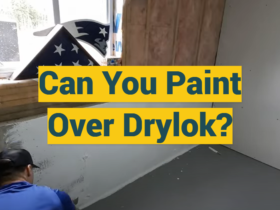
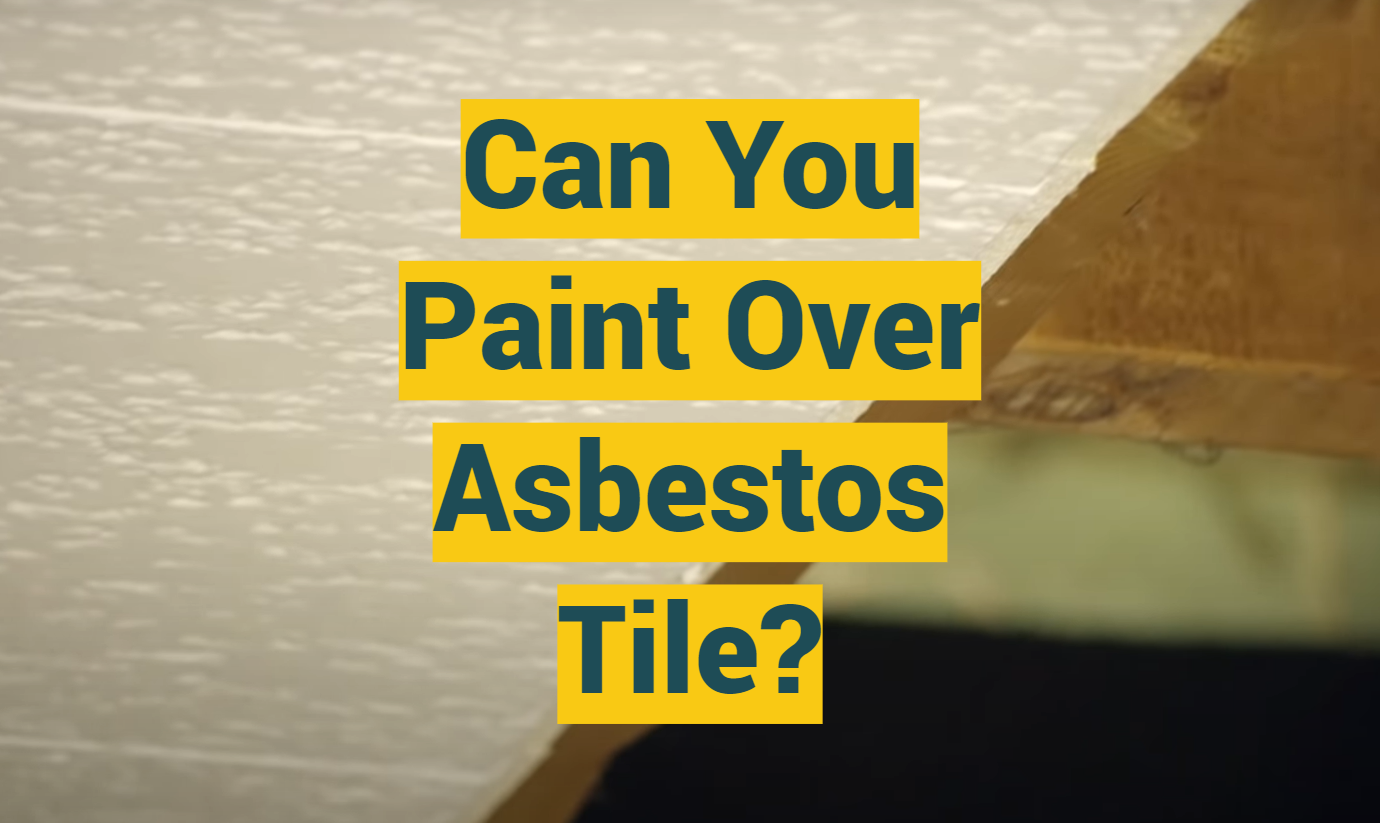




Leave a Review